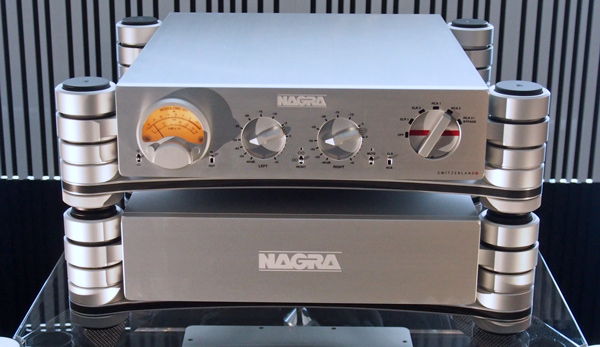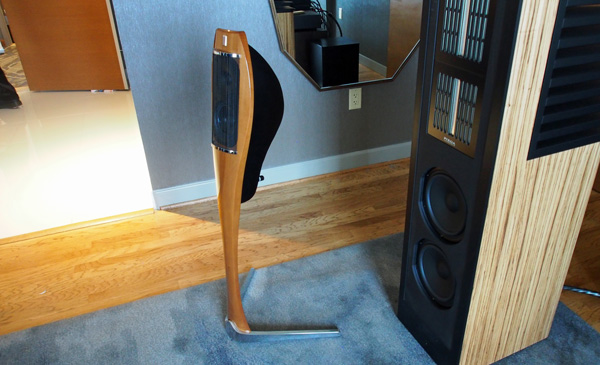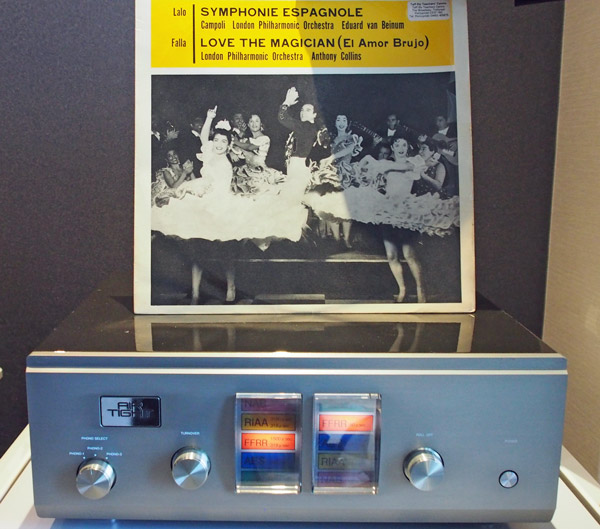| Columns Retired Columns & Blogs |
I always thought the Franco Serblin Ligna speakers looked cute.
But I think the movie Prometheus has ruined them for me ;-)

The large speaker is the HHR Exotic TLS-1 ($15,000/pair) and uses a single 12" Walsh-style drive-unit with a 3" edge-wound voice-coil in a 3ft3 cabinet. The smaller speaker is the TLS-5 ($7500/pair), which combines two Walsh-type drive-unit using a crossover that doesn't use resistors, just inductors and Mundorf capacitors. With a Krell Duo 300 amplifier ($9500), Krell Illusion preamp ($15,000), a Q-Sonix 210 server ($8250), a PS Audio P300 Power Plant ($2500), and HHR Exotic cabling, the sound of the single-driver, omnidirectional TL-1s on "So What" from Kind of Blue was remarkably coherent from bottom to top and reminded me of a Miles Davis video. To my surprise, the video shows bassist Paul Chambers playing the riff by moving his left hand, continually changing position, instead as I always thought, keeping his hand in one position and playing across the strings, which is how I play the riff. You live and learn!

The Walsh drivers use what is called a "bending-wave" diaphragm and in the Elite Audio Systems room next door, Daniela Manger was showing the two-way P1 speaker ($12,000/pair) which use the star-shaped bending-wave drive-unit developed by her late father Josef to cover the range from 360Hz to 45kHz and has a claimed risetime of 12µs, of the same order as the human hearing system's. This unique driver also has two voice-coils wound so as to cancel back EMF. Frequencies below 360Hz are handled by an 8" woofer in a sealed enclosure. I joked with Ms. Manger that I was taught at school that a bending-wave diaphragm is very inefficient at transmitting acoustic power but on the Analogue Productions reissue of Paul Simon's Graceland LP, the sound was rich, clean, and uncolored.

Amplification for the Manger speakers was all from Viola Audio Laboratories: the Sonata preamplifier ($38,000, above), which can be controlled with an Apple iOS app and has a DAC module, and Concerto power amplifier ($22,000, 125Wpc).

Source was the Spiral Groove Revolution player ($17,995) fitted with a My Sonic Lab Signature Platinum phono cartridge.

Retailer Musical Artisans was showing Nagra source and amplification components—Nagra HD monoblock amplifiers ($86,000/pair) and the Nagra HD DAC with two MPS power supplies and two VFS isolation bases ($44,475)—with Kharma DB-11s loudspeakers ($54,000/pair), all hooked up with Argento Extreme cabling. The room featured dispersive panels at the sidewall reflection points and in front of the hotel room's flat-panel TV. The sound was superb, a 24/192 file of a jazz piece for piano and flugelhorn, backed by strings, sounding richly detailed.

Taking pride of place in the Musical Artisans system was Nagra's new HD preamplifier ($59,500), which uses one tube per channel and has, I was told a noise floor 160dB down from peak level. (FFT bin level, I assume, rather than Signal/Noise Ratio.) I found that hard to believe, as it implies ultra-low circuit impedances and operating at cryogenic temperatures, but I was assured that it was the case, achieved with transformer coupling and careful power-supply design using super-capacitors.

Nagra gear was also featured in the David Michael Audio room, with again the HD preamplifier, a Nagra HD monoblock amplifiers ($86,000/pair), the Nagra HD DAC ($30,995), a Nagra VPS phono preamplifier ($7995), a Nagra MPS power supply powering the DAC and phono preamp ($6795), along with an Aurender W20 server ($17,600), a Döhmann Helix 1 turntable with Schroeder tonearm ($44,800), a Phasemation PP2000 MC cartridge ($5550), Kubala Sosna interconnects and power cords, and Modulum Audio Platforms.
But what caught my eyes (and ears) in this room was the Graham LS5/8 loudspeakers ($13,000/pair in cherry veneer). A re-creation of the classic two-way BBC monitor design from the early 1970s, with erstwhile Spendor designer Derek Hughes involved, this speaker goes against everything I have learned about optimal system design, with a 1.5" tweeter married to a 10" woofer in a wide-baffled, thin-walled enclosure. You'd expect the imaging to be diffuse and there to be an off-axis gully in the speaker's lateral radiation pattern, due to the large woofer becoming directional in its top octave before handing over to the wider-dispersion tweeter. But that didn't seem to be the case, a piano-jazz LP of the Shoii Yokouchi Trio, Greensleeves, sounding clean and natural, with precise, palpable stereo imaging. Looks can be deceiving.

The Swiss Piega loudspeaker brand has been absent from the US for many years, but has been brought back by Axiss Audio, who were demonstrating the Master Line Source 2 ($88,000/pair) at AXPONA, driven by a Soulution 330 integrated amplifier ($22,500 plus $3500 for DAC module) or a Soulution 325 preamplifier and 311 power amplifier (both price TBD). Cabling was all Wireworld. The Maazel/VPO Mahler 5 sounded enormous, a big sweep of sound.

As Axiss Audio's Arturo Manzano shows, the Piega speaker's planar drivers act as a dipole, with an elaborate waveguide array shaping the backwave.

Sitting to the sides of the big Piegas were a pair of Franco Serblin Ligna speakers ($6000/pair), the final design from the late founder of Sonus Faber. I didn't get to hear them, but this was the most elegantly styled speaker I saw at AXPONA.

In the other Axiss room, a system was set-up with AirTight's new ATM3211 monoblock amplifiers ($72,000/pair), which use a pair of 201 triodes in push-pull. Specified output power is 120W into 8 ohms.

But what AirTight's Yutaka "Jack" Miura was keen to show me was the Japanese company's ATE-3011 phono preamplifier, which will be available in December. Using three 12AX7 tubes, this offers three MM inputs and eight independent HF and LF turnover/rolloff points for its equalization, allowing the playback to be optimized for a large number of pre-RIAA curves. As well as RIAA, the ATE-3001 can be easily set-up using front-panel pushbuttons for NAB, AES, ffrr, ffss, as well as, for example, Columbia, which is selected by choosing FFRR for turnover and NAB for rolloff. In my photo, Jack has selected ffrr for the mono Decca LP of orchestral works by Lalo and de Falla.
This was the last room I visited at AXPONA, and my apologies to those rooms I still had to visit when time ran out at 4pm Sunday. This was a great show—the Schaumburg Renaissance hotel was a superb location for an audio show: rooms generally sounded excellent; the corridors were sufficiently spacious that you never felt crowded; and JD Events did a great job. Looking forward to the 2019 show!

I always thought the Franco Serblin Ligna speakers looked cute.
But I think the movie Prometheus has ruined them for me ;-)

Nice work! by you and your crew -JA.
Good to read so much coverage on CD/SACD players. I knew these formats were far from dying.